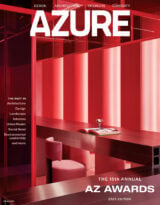
Emerging and established designers alike joined forces at our fave quartet of Milan Design Week 2025 off-site events. Below, our whirlwind tour of Capsule, Convey, Alcova and MoscaPartners Variations reveals emerging design trends, thoughtful installations and even a free beard trim.

1
Capsule
Started in: 2023, by Alessio Ascari as a spinoff of Capsule magazine. Each show is co-curated with architect Paul Cournet.

Known for: Courting the cool kids. This year, that included Nike and Stone Island, plus zeitgeisty creative director Willo Perron. The Montreal-born, L.A.-based designer worked with Sweden’s NO GA to develop a system of cast glass-fibre seating and table modules that filled the courtyard of Capsule’s main venue, Spazio Maiocchi (normally a Porta Venezia arts centre also run by Ascari).


This year’s trends: Clean lines and hard metal. Norwegian aluminum manufacturer Hydro presented concepts — including a pair of trash bins by Stefan Diez and patio chairs by Takeuchi — made from recycled scrap sourced within 100 kilometres of Milan. Meanwhile, Humanrace (Pharrell’s skin care line) teamed up with USM to reimagine its modular steel Haller system as a freestanding green bathroom — complete with USM shower and towel rack, plus Laufen fixtures — and Georg Jensen opened a gelateria that encouraged people to enjoy their ice cream with a sterling silver version of the disposable spoons that typically accompany the dessert.

The biggest surprise: The never-ending slumber party being thrown on Hem’s modular Great Sofa, designed by Philippe Malouin and launched alongside a retrospective of the Swedish brand’s first 10 years.

2
Convey
Started in: 2023, by Milan creative strategy firm Simple Flair.

Known for: Incubating the next generation of buzzy industrial design companies (for instance, Bosnia’s wood-focused Woak, plus Simple Flair’s own brand, Vero) by putting them in the same room as Italian stalwarts like Campeggi, Acerbis and Meritalia.

This year’s mood: Packaging tape delineated brand displays, giving the whole thing an ad-hoc, moving-day feel. True to that style, pieces felt special but not overly precious. A plastic suitcase by the appropriately named Crash Baggage is sold pre-crumpled (exactly how we felt at the airport on our way out of town), while Paolo Ferrari’s handsomely curved wood Arche dining chair for SEM, shown in a range of finishes but especially striking in glossy lacquered red, captures the spirit of Italian sprezzatura.

The biggest surprise: Along with the main exhibition (held in what is usually fashion label Durazzi’s Porta Venezia showroom), Simple Flair also spread designs across nearby businesses. Mirrors by NYC’s Ready to Hang even adorned a barbershop that provided Convey visitors with free beard trims.

3
Alcova
Started in: 2018, by former magazine editors Valentina Ciuffi and Joseph Grima.

Known for: Its surprising venues, which included a defunct panettone factory one year and a former military hospital another. This April, Alcova made the most unexpected move yet by returning to its 2024 location, a pair of villas in the Milanese suburb of Varedo. That said, it still upped the ante by expanding to two other Varedo buildings: the former SNIA textile factory, and the Pasino greenhouses, once home to Europe’s largest
cultivation of white orchids.



This year’s trends: Post-apocalyptic rebirth (see: totems tiled in volcanic stone by Ranieri, plus magma-like ceramic lamps by Forma Rosa Studio) meets green-thumbed horticulturalism (reflected in clay workshop Terraformæ’s terracotta cladding, but also by several visitors wearing gardening clogs). The two themes merged in Ghost Orchid, Polish designer Marcin Rusak’s otherworldly floral sculptures (shown at the top of the page) made from 3D-printed PLA derived from corn starch.

The biggest surprise: A marble phallus (Pervert, by Inderjeet Sandhu) urinating into a sink in one of the bathrooms…Alcova is as irreverent as it is intellectual.

4
MoscaPartners Variations
Started in: 2014, by the design curation studio MoscaPartners.

Known for: Taking over Palazzo Litta’s courtyard and interiors with thought-provoking exhibitions that span disciplines.

This year’s mood: An insightful and immersive installation set the scene from the moment you entered the courtyard. Nobody Owns the Land: Earth, Forest, Mahk, by Byoung Soo Cho, invited visitors to take off their shoes and walk in the red earth covering an elevated platform. The first work the Korean architect has ever installed in Italy, it introduced a moment of respite (as well as a provocative statement) into the novelty-driven madness of design week — and served as a serene introduction to the 24 exhibitors from 12 countries whose works were displayed throughout.

The biggest surprise: Trace of Water by Japan-based design lab Honoka with water filtration non-profit Aqua Clara demonstrated the aesthetic potential of recycled plastic. A luminous curved wall and a series of homewares made of the crushed, crystalline remnants of water jugs left many buzzing about just how beautiful — and luxurious — the material can be.
4 Milan Group Shows that Rewarded Offsite Exploration
From volcanic tiles to dignified trash cans, Milan’s group exhibitions showcased fresh experimentation.
